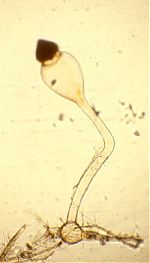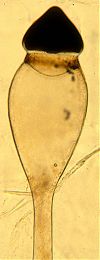Pilobolus
PILOBOLUS Tode: Fr., 1832 (Syst. Mycol. 3:312); 10 to 13 spp. + 2 varieties (Grove, 1934—ILLUS. and KEY TO SPP.; McVickar, 1942—illus.; Lyr, 1954—llus.; Nand and Mehrotra, 1968—illus. and key to spp., 1977—illus. and key to spp.; Hu et al., 1989—monograph)
? Pilobolus Tode, 1784 (In Schrift. Berl. Gesell. naturf. Fr., 5:46).
= Pycnopodium Corda, 1842 (Icon. Fung. 5:18; fide Hesseltine, 1955).
Pilobolus produces sporangia that are attached to the constriction above the vesicle along a circumscissle zone. The sporangium, which has a black, cutinized wall is forcibly shot from the sporangiospore. The sporophore which is generally simple arises from a trophocyst. Zygospores are formed in the substrate and they have apposed suspensors. These fungi are obligate coprophiles.
Type species: P. crystallinus
Species of Pilobolus:
P. crystallinus var. crystallinus Tode: Fries, 1832 (Systema mycologicum 3:312.
P. crystallinus Tode: Fries var. hyalosporus (Boedijn) Hu & Zheng, 1989 (Mycosystema 2:119) .
P. crystallinus var. kleinii (van Tieghem) Zheng & G.-q. Chen, 1989 (Mycosystema 2:119
P. exiguus Bainier, 1882 ( Étude sur les Mucorinées, p. 47) non Pilobolus exiguus Bainier, 1883 (Ann. Sci. Nat., Bot., Sér. 6, 15:81).
P. lentiger var. lentiger Corda, 1837 ( Icon. Fungorum 1:22).
P. lentiger var. minutus (Speg.) Zheng & G.-q. Chen, 1989 (Mycosystema 2:122)
P. longipes van Tieghem, 1878 (Ann. Sci. Nat., Bot., Sér. VI, 4:338).
P. nanus van Tieghem, 1878 (Ann. Sci. Nat., Bot., Sér. VI, 4:340).
P. oedipus Mont., 1836 (Mém. Soc. Linn. Lyon 1836:1).
P. pullus Massee, 1901 (Kew Bulletin 1901:106).
P. roridus var. roridus Bolton: Fries, 1823 (Syst. mycol. 2:309) .
P. roridus var. umbonatus (Buller) Hu & Zheng, 1989 (Mycosystema 2:129).
P. sphaerosporus Palla, 1900 (Österr. Bot. Zeit. 50:400).
Grove (1934) recognizes nine species and Hu et al. (1989) treat five species and nine varieties. Pilobolus sporangia are known to aid in the transmission of the cattle lungworm (Eysker, 1991). Pilobolus spp. will only grow on a culture medium containing hemin (Levetin and Caroselli, 1976) or a medium with dung extract. Pilobolus spores will germinate after they, singly or in sporangia, have been transferred to the surface of the appropriate culture medium and incubated overnight at 37 C (Bourret and Keierleber, 1980). Light is required for species of Pilobolus to form trophocysts and sporangia (Page, 1962).
Bibliography
Bourret, J.A., and C. Keierleber. 1980. Iron and temperature as sporangiospore germination factors of Pilobolus longipes. Arch. Microbiol. 126:43-49.
Eysker, M. 1991. Direct measurement of dispersal of Dictyocaulus viviparus in sporangia of Pilobolus species. Res. Vet. Sci. 50:29-32.
Grove, W. B. 1934. A systematic account and arrangement of the Pilobolidae., pp. 190-224, In A. H. R. Buller. Researches on Fung. Vol. 6. London, Longmans Green and Co. 513 p.
Hu, F.-m., R.-y. Zheng, and G.-q. Chen. 1989. A redelimitation of the species of Pilobolus. Mycosystema 2:111-133.
Levetin, E, and N.E. Caroselli. 1976. A simplified medium for growth and sporulation of Pilobolus species. Mycologia 68:1254-1258.
McVickar, D.L. 1942. The light-controlled diurnal rhythm of asexual reproduction in Pilobolus. Am. J. Bot. 29:372-380.
Nand, K., and B.S. Mehrotra. 1968. Species of Pilobolus and Pilaira from India. Sydowia 22:299-306.
Nand, K., and B.S. Mehrotra. 1977. Species of Pilobolus and Pilaira from India. Sydowia 30:283-289.
Page, R.M. 1962. Light and the asexual reproduction of Pilobolus. Science 138:1238-1245.
Updated Mar 13, 2005


